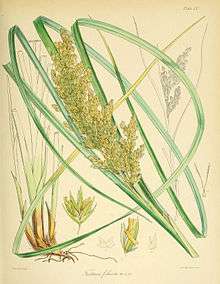Poa foliosa
Poa foliosa is a species of tussock grass commonly known as muttonbird poa. It is native to the subantarctic islands of New Zealand and Australia.
| Poa foliosa | |
|---|---|
 | |
| Plate LV (artist Fitch)[1] | |
| Scientific classification | |
| Kingdom: | Plantae |
| Clade: | Tracheophytes |
| Clade: | Angiosperms |
| Clade: | Monocots |
| Clade: | Commelinids |
| Order: | Poales |
| Family: | Poaceae |
| Subfamily: | Pooideae |
| Genus: | Poa |
| Species: | P. foliosa |
| Binomial name | |
| Poa foliosa | |
| Synonyms | |
| |
Description
Poa foliosa is a perennial, dioecious grass growing as densely clumped tussocks up to 2 m in height. The tussocks arise from short, woody stolons, with the shoots covered at the base by the fibrous remnants of sheaths. The leaf-blades are 150–400 mm long and 3–6 mm wide. The plant flowers from October to December, and fruits from November to April.[5][6]
Distribution and habitat
In New Zealand the grass is found on the north-eastern Titi, or Muttonbird, Islands, as well as on the Solander, Snares, Antipodes, Auckland and Campbell Islands. It is also found on Australia's Macquarie Island. The habitat is coastal and subcoastal, often near seabird colonies.[5]
Macquarie Island
On Macquarie Island's coastal terraces and slopes it grows in mixed stands with Stilbocarpa polaris where the drainage is good, and along the borders of streams. It forms a tall tussock grassland along the beaches above the high-water mark, as well as patchily on the island's plateau in sheltered and relatively exposed sites. The upland grasslands are an important habitat for burrow-nesting petrels, rabbits and mice. Where rabbit grazing is controlled, Poa foliosa tall tussock grassland becomes more widespread.[7]
Taxonomy
The species was first described in 1845 as Festuca foliosa by Joseph Hooker.[3][1] In 1864 he redescribed it as belonging to the genus, Poa.[4]
Conservation status
In both 2009 and 2012 it was deemed to be "At Risk - Naturally Uncommon" under the New Zealand Threat Classification System,[5] and this New Zealand classification was reaffirmed in 2018 (due to its restricted range), with a further comment that it was safe overseas.[2]
References
- Hooker, J.D. (1845). "Festuca foliosa". The botany of the Antarctic voyage of H.M. discovery ships Erebus and Terror in the Years 1839-1843 :under the command of Captain Sir James Clark Ross. 1: 99. Plate LV
- de Lange, P.J.; Rolfe, J.R.; Barkla, J.W.; Courtney, S.P.; Champion, P.D.; Perrie, L.R.; Beadel, S.M.; Ford, K.A.; Breitwieser, I.; Schönberger, .; Hindmarsh-Walls, R. (2018-05-01). "Conservation status of New Zealand indigenous vascular plants, 2017" (PDF). New Zealand Threat Classification Series. 22: 47. OCLC 1041649797.CS1 maint: numeric names: authors list (link)
- "Poa foliosa (Hook.f.) Hook.f | Plants of the World Online | Kew Science". Plants of the World Online. Retrieved 2020-02-09.
- Hooker, J.D. (1864). "P. foliosa". Handbook of New Zealand Flora. 1: 338.
- "Poa foliosa". New Zealand Plant Conservation Network. Retrieved 2011-01-03.
- Clayton, W.D.; Harman, K.T.; & Williamson, H. (2008-01-28). "Poa foliosa". GrassBase. Royal Botanic Gardens, Kew. Retrieved 2011-01-03.
- "Macquarie Island flora". Australian Antarctic Division. 2010-08-12. Retrieved 2011-01-03.
